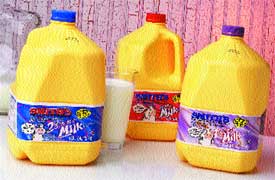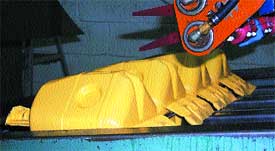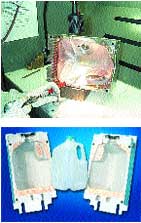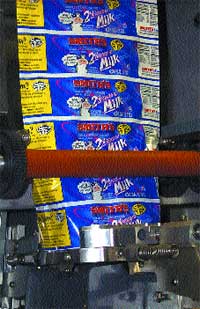January 29, 2014
While Smith Dairy, a self-described "dairy in the country," located in Orville, OH, has focused on new packaging concepts and flavor options for single-serve milk containers, it decided recently to create a distinctive new look for large gallon-sized dairy containers to help make those sizes more competitive. When its molds for gallon bottles needed replacing, the company decided a fresh design was in order and turned to Portola Allied Tool, a newly formed, specialized business unit of Portola Packaging, Inc., to quench its thirst for turnkey design and mold manufacturing assistance.
Along with milk, juices and drinks, Smith produces the single-serve Moovers brand of grab-and-go beverages in bottles with handsomely printed full-body sleeve labels as well as an array of cultured dairy products including cottage cheese, sour cream and dips. The products are distributed throughout Ohio as well as in Kentucky, Indiana and Michigan. Setting an innovative pace is a main priority at Smith, explains production manager Karl Kelbly. When the company decided to give the 1-gal blow-molded bottles a facelift, it wanted a versatile structure that could handle different types of labels. "We needed a container for milk and juice that would be able to accept either a [film] wraparound sleeve or a standard paper label, while still maintaining good top-load strength, and handle capping well. We also wanted a new design that would help us with our branding efforts."
The resulting customized container is what Smith calls the Super Juge, a sleek, gallon bottle weighing 60 grams empty that has become a Smith original. Pigemented yellow for milk products and left clear for orange juice, the new bottle structure is driving product appeal, increasing sales by double digits, says Bill McCabe, vp of marketing. "After a few months, we began to see a great response from retailers and consumers. They love the yellow jug and the label. Market distribution of the products has expanded quite a bit. Retailers who only carried private labels now carry our brands." No pint-sized independent, family-owned and operated Smith is considered the largest independent dairy in Ohio. A progressive company, Smith has a manufacturing plant in Orville that includes in-house blow-molding capabilities, and operates a dairy in Richmond, IN. The company produces a large line of products under its own name.
|
Just-molded yellow-pigmented bottles are placed onto a cooling bed. After they're trimmed, they head to an annealing station before they're stretch-banded with a full-wrap label. |
Smith realized two years ago that a structural change was needed for its high-density polyethylene milk and juice bottles. Having worked with Portola previously on refurbishing existing molds and consumable tooling projects, the company consulted with Portola Allied Tool again. A wholly owned business unit of Portola Packaging, a supplier of plastic closures and related equipment for dairy, water, juice and institutional food industries, Portola Allied Tool specializes in creating single- and multicavity molds, machine components, tooling and design services for dairy, juice and water applications.
As Portola Allied Tool set out to develop a prototype bottle mold design for Smith's new gallon, discussions unfolded. "We realized that Portola's specialized design services would be able to deliver something that could give our products a unique look and separate them from other products on the shelf," Kelbly says.
The multicavity molds were designed via a combination of three-dimensional modeling and computer numeric control (CNC) machining to provide a high degree of uniformity. While the juice containers are molded of contact-clear HDPE, Smith prefers to pigment the milk gallons yellow to protect the milk's flavor and nutrient value. The food-grade yellow colorant is from Ferro Corp.
Getting yellow's message across
The Super Jug features starburst fluting molded into the base of the neck to the shoulder, which adds strength as well as a design element specific to Smith Dairy. A textured surface handle area makes the bottle easier to grip and adds strength, while the same type of textured finished on the base adds sidewall strength. An ample, recessed label panel provides room for a "slip-label," or stretch-band film label, to be applied, which increases the billboard space Smith can use to feature the milk's "Why Yellow?" bottle story.
Concurrently with the development of the new bottle molds, Smith redesigned the label graphics with help from Smiley-Hanchulak. The color-coded PE film label band from MRI Flexible Packaging and Pechiney affords maximum graphic potential, McCabe says.
|
Airplane-grade aluminum molds, like the half assembled for Smith's Super Jug, top photo, can be specially designed for bottle sizes from 4 oz to 7 gal. Smith's displays a custom starburst design on the shoulder. |
"It was very important to educate consumers about why our bottle is yellow. There's so much more label space in which to provide informative copy, that the campaign is really getting our message across. We really wanted the full-wrap label band. The gallon milk bottle has been a commodity item, and we're trying to take it away from that look and price point."
Impactful, point-of-sale label graphics, including brand and product details, the Super Jug story, Nutrition Facts and answers to commonly asked questions are flexo-printed in six colors on the four wraparound label panels. A swirl-design background adds eye appeal, as does the Super Jug "talking cow" that illustrates bottle benefits, updating Fat-Free Skim, Vitamin D, Fat Free 1% and Reduced Fat 2% milks. "The updated swirl background of the graphics reflects our corporate packaging theme and the graphics talk about how the yellow bottles guard the milk against harmful light that can break down flavor and vitamins," McCabe says.
The clear juice gallon containers for orange juice get a similar color-coordinated label. Measuring about 21/2 in. wide, the stretch band label attracts plenty of attention in dairy cases, McCabe tells PD. Although stretch labels are still not widely used on gallon jugs, they are becoming more popular, relates Portola Allied Tool's Billy Epperson, director of sales and marketing. "Milk marketers have been asking for a way to enhance milk. While milk itself can't exactly change all that much [except in flavor and color], customers are experimenting with packaging. For the standard gallon jug, there have been some changes in the last several years, but most of the changes were legislated, which didn't make much difference from a marketing standpoint. We're trying to offer new looks and the ability to incorporate the larger wrapround labels, which more marketers want as a way to add promotional information and graphics all the way around the bottle.
"We're hoping to see more creativity like Smith's come to the dairy market," Epperson says.
Capping the beaded container necks are color-coordinated, snap-on/twist-off, foil-lined, threaded closures molded of low-density PE by Berry Plastics. A stylized recycling symbol with two chasing arrows appears to the left of the handle.
Customized approach
Increased consolidation and competition in the dairy industry have caused many companies to take a more customized approach to container design, notes Pat Taylor, engineering manager at Portola Allied Tool, who worked closely with Smith on mold creation from Portola's facility in Michigan Center, MI.
"Smith was looking for a gallon dairy jug that could accommodate a slip label as well as an existing paper label. They also wanted a container that could distinguish them from all the other dairies. Capabilities such as stretch labeling of gallon dairy bottles allow companies like Smith to increase advertising and marketing efforts in ways that weren't possible before," Taylor says. "We helped them tap into a range of marketing/labeling possibilities."
 With numerous machining operations, Portola Allied Tool produces molds for container sizes from 4 oz to 7 gal, designing and manufacturing molds for use with HDPE, LDPE, polypropylene and assorted other plastics. In Smith's case, Portola took the Super Jug design into prototype modeling using PRO E/3-D, a three-dimensional computer design/engineering software system that affords complicated, efficient tooling.
With numerous machining operations, Portola Allied Tool produces molds for container sizes from 4 oz to 7 gal, designing and manufacturing molds for use with HDPE, LDPE, polypropylene and assorted other plastics. In Smith's case, Portola took the Super Jug design into prototype modeling using PRO E/3-D, a three-dimensional computer design/engineering software system that affords complicated, efficient tooling.
Creating the molds at the computer stage, before investments are made in metal molds, is especially important, Taylor points out, considering that a single- or multiple-cavity mold will last in continuous operation for more than a decade. "We model everything at the computer, from determining container wall thickensses to working on the container esthetics. On projects like this one, which was something new in gallon design, we produced a unit-cavity mold and ran trials and top-load, side-impact and drop tests to see where adjustments needed to be made." Portola also submitted pictures of the models to Smith before producing three-dimensional models. "That way, customers can get an idea of the look and feel of a bottle and see something before we actually cut any metal for a mold," Taylor says.
"Customers are starting to label [dairy] packages differently from one production run to another, so the label panels are becoming larger on gallon dairy bottles."
After design iterations and the tests were conducted on sample molds and bottles with Smith's input, a production set of molds, including two complete unit cavities, was approved. The Super Jug molds project was completed in approximately seven months, Taylor says, from drawing concepts to finished containers. In order to meet production quantity requirements, Portola Allied produced 14 individual molds for use at Smith's manufacturing plants as well as for a contract manufacturer. The molds were constructed of airplane-grade aluminum for optimum strength and thermoconductivity.
|
At Smith's plant in Orville, OH, a pair of stretch label applicators were purchased to apply the wraparound stretch sleeves. |
Portola Allied produced two sets of four production molds, or eight total, for use at the Orville plant and another set of six for the bottles that are produced for use at the Richmond plant. Neck ring top blocks, shear steel strikers, neck ring inserts, blowpins, trim and deflashing tools were provided. "Portola volume-corrected, tested and installed the molds," says Kelbly.
A bang for the buck
At its fluid milk plant in Orville, Smith blow-molds the bottles four-up on two four-head Uniloy molding machines using bulk HDPE resin from Solvay. After molding, the containers are trimmed and cooled in-line before they submit to a pressure test that checks each bottle for leakage. They are then sent through an annealing unit, which shrinks them down to the proper size and prepares them for labeling. Next comes labeling, for which Smith installed two new Comag stretch banders from Italy that allow the company to implement a range of cost-effective branding promotions, advertising programs, and graphic changes, McCabe says. After the label bands are applied, the bottles, under heavily monitored conditions, are filled on two Federal 26-valve rotary filling systems and are automatically transferred to 120-count stainless-steel dairy racks or crates.
With its broad label panel, the new Super Jug container is allowing Smith to move forward in reinforcing its milk brands, Kelbly says. "Portola Allied Tool helped us look at all of the options and get the most 'bang' for our investment. The strengths of the bottle design and the label work hand-in-hand to fulfill several goals. With the new containers, we can provide billboarding, co-branding, cross-merchandising and couponing, right on our own products."
More information is available:
Moldmaking, container design: Portola Allied Tool, Inc., 517-764-5554. Circle No. 225
Label graphics: Smiley-Hanchulak, Inc., 330/666-0868. Circle No. 226.
Stretch-band labels: MRI Flexible Packaging, 800/448-8183. Circle No. 227.
Stretch labels: Pechiney Plastic Packaging, 773/399-8000. Circle No. 228.
Bottle colorant: Ferro Corp., 216/641-8580. Circle No. 229.
Bottle resin: Solvay Polymers, Inc., 800/231-6313. Circle No. 230.
Closure: Berry Plastics Corp., 812/424-2904. Circle No. 231.
Blow molders: Uniloy Milacron, 800/666-8852. Circle No. 232.
Fillers: Federal Mfg. Co., v414/384-3200. Circle No. 233.
Label applicators: Comag, s.r.l., 11 39 0776 7711 Circle No. 234.
About the Author(s)
You May Also Like





